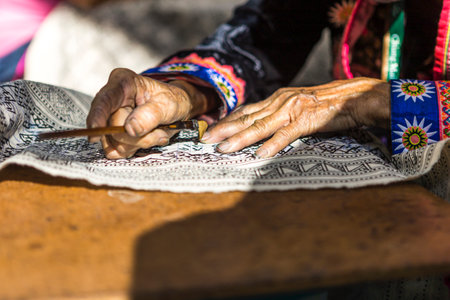Celebrating India’s Handmade Heritage
India is a land where tradition and artistry blend seamlessly, giving rise to a vibrant legacy of handmade furniture. The intricate woodwork of Saharanpur, the delicate cane weaving in Assam, and the colourful inlays from Rajasthan all speak of centuries-old skills handed down through generations. In today’s fast-paced world, mass-produced furniture has flooded the market, often overshadowing these unique creations. Yet, supporting local artisans is not just about buying a piece of furniture—it is about honouring a rich heritage that defines Indian culture. Preserving traditional artisan skills is crucial as it keeps alive stories, techniques, and values that have shaped communities across the country. Embracing handmade furniture allows us to celebrate the diversity and beauty of India’s craftsmanship while ensuring that these age-old traditions continue to thrive even as we move towards modernity.
The Economic Backbone: Empowering Local Artisans
When we look at the heart of India’s handmade furniture industry, it is impossible to ignore the role played by local artisans. Across bustling towns and quiet villages, these skilled hands transform raw materials into stunning pieces of art. Handmade furniture is not just a product—it is a livelihood for millions. In rural belts from Rajasthan to Kerala, families have relied on woodcraft, cane weaving, and metalwork for generations. This traditional sector serves as an economic backbone, directly supporting the day-to-day lives of countless Indian households.
Livelihoods Rooted in Tradition
For many artisans, their craft is more than just work; it is an inheritance passed down over centuries. The handmade furniture sector creates sustainable employment opportunities that often require little capital investment but immense skill. By choosing locally made furniture, consumers actively participate in this cycle—helping preserve artisanal knowledge while ensuring regular income for craftsmen and women.
Economic Impact Across Rural India
This industry’s ripple effect can be seen in how it uplifts entire communities. As artisans gain orders and recognition, their improved financial stability leads to better education for children, healthcare access, and overall community development. Many artisan clusters also form self-help groups and cooperatives, empowering members with bargaining power and collective growth. Here’s a quick look at how the sector supports different stakeholders:
| Stakeholder | Benefit | Local Example |
|---|---|---|
| Artisan Families | Sustainable Income & Skill Preservation | Woodcarvers in Saharanpur |
| Women Artisans | Employment & Social Empowerment | Cane Weaving Units in Assam |
| Youth | Training & Entrepreneurship Opportunities | Youth-led Workshops in Jaipur |
| Entire Communities | Community Development Projects Funded by Artisan Co-ops | Kutch Village Collectives |
A Movement Beyond Wages: Uplifting Aspirations
The success of this sector goes beyond mere wages—it is about dignity, pride, and aspirations fulfilled within homegrown communities. When local artisans thrive, villages flourish, youth stay rooted to their heritage, and the entire nation witnesses a renaissance of Indian design. Supporting handmade furniture thus becomes an act of empowerment—fueling both social transformation and economic resilience across India.
![]()
3. Social Impact: Fostering Identity & Pride
When we talk about handmade furniture in India, we are not merely discussing products; we are celebrating centuries-old traditions, intricate craftsmanship, and the unique stories of each region. Supporting local artisans goes beyond economic benefit—it acts as a bridge connecting modern India with its rich heritage. Every piece of hand-carved wood from Rajasthan or inlaid marble from Agra carries the essence of the community that creates it, echoing the voices of generations past.
Reviving Regional Traditions
In cities like Jaipur, Mysuru, or Varanasi, traditional furniture styles reflect regional aesthetics and skills. By choosing locally made pieces, Indian households and businesses become stewards of these age-old crafts. This conscious support helps revive dying techniques such as Kashmiri papier-mâché or Chettinad woodwork, ensuring they are passed down to future generations rather than lost to mechanized production.
Building Community Pride
When artisans see their handiwork valued within their own country and around the world, it sparks immense pride in their communities. This recognition validates years of dedication and expertise, motivating younger generations to embrace their cultural roots instead of migrating towards generic factory jobs. Communities flourish as they rally around their shared identity and contribute to a collective sense of achievement.
A Shared Sense of Belonging
Handmade furniture becomes more than just décor—it transforms into a symbol of Indian resilience and creativity. Homes adorned with local handiwork tell stories that resonate with family members and guests alike, creating a shared narrative rooted in respect for tradition. In this way, supporting local artisans is not just an act of purchase but an affirmation of India’s vibrant cultural mosaic.
Sustainability in Every Stitch and Carving
Handmade furniture in India is not just about aesthetics; it is deeply rooted in the principles of sustainability. Indian artisans, with their generations-old wisdom, have always embraced eco-friendly practices that go beyond trends and speak to a deep respect for nature. This commitment to sustainability is evident in every stitch and carving of locally crafted pieces.
Eco-Friendly Practices: A Tradition Revived
Unlike mass-produced furniture, handmade items are typically created using techniques that minimise waste. Artisans often use reclaimed wood, natural dyes, and traditional joinery methods that avoid harmful chemicals. Many workshops operate as family businesses, where resourcefulness is a way of life—scraps are reused for smaller items or as fuel, ensuring minimal environmental footprint.
Indigenous Materials: The Soul of Indian Craft
The choice of materials reflects a profound connection to the land. From robust Sheesham (Indian Rosewood) to bamboo and cane harvested sustainably from local forests, each piece tells a story of its origin. By opting for indigenous materials, artisans support local economies while reducing transportation emissions associated with imported goods. Here’s a snapshot of commonly used materials and their sustainable features:
Material |
Region Sourced |
Sustainable Features |
|---|---|---|
| Sheesham Wood | Rajasthan, Uttar Pradesh | Fast-growing, durable, locally sourced |
| Bamboo & Cane | Northeast India, Kerala | Renewable, grows quickly without pesticides |
| Mango Wood | Maharashtra, Karnataka | Byproduct of fruit industry, reduces waste |
| Cotton & Jute Upholstery | West Bengal, Andhra Pradesh | Biodegradable, supports rural farmers |
The Slow-Made Philosophy: Celebrating Time and Craftsmanship
The philosophy of ‘slow-made’ is at the heart of Indian handmade furniture. Unlike fast-furniture trends that encourage disposability, slow-made pieces are crafted with patience and intention. This approach nurtures both the maker and the end-user—a chair or table becomes an heirloom rather than landfill fodder. The time invested ensures durability and uniqueness; no two pieces are ever identical.
A Collective Movement Towards Greener Living
By supporting handmade furniture from local artisans, Indian consumers are championing a greener future. Each purchase is a conscious step toward sustainability—uplifting communities while preserving precious natural resources for generations to come.
5. From Local to Global: The Changing Face of Retail
The landscape of Indian handmade furniture is experiencing a vibrant transformation, as the craft journeys from humble local bazaars to the dazzling global stage. Traditionally, Indian artisans showcased their skills in narrow lanes and weekly haats, selling their masterpieces to local patrons who understood the value of handcrafted beauty. Today, however, the narrative is shifting in exciting ways.
Domestic Appreciation Meets Global Demand
Indian households have always had a deep respect for artisanal craftsmanship, often favouring solid wood pieces with intricate carvings and vibrant finishes over mass-produced alternatives. But now, this love for handmade furniture is echoing beyond India’s borders. International buyers are waking up to the charm and sustainability of Indian creations—whether it’s a Rajasthani jharokha mirror or a Kerala rosewood dining set. These unique pieces are increasingly finding homes in New York lofts, London apartments, and Dubai villas.
E-Commerce: A Game Changer
The rise of e-commerce platforms has been a true game changer for India’s artisans. Marketplaces like Amazon India, Pepperfry, and even niche portals such as Jaypore are connecting rural craftsmen directly to customers across continents. This digital leap has made it possible for even small-scale makers in Jaipur or Saharanpur to reach design-conscious buyers in Mumbai or Melbourne without leaving their workshops.
Challenges and Opportunities
Of course, going global brings new challenges—maintaining quality standards, managing logistics, and adapting designs to suit varied tastes. Yet, these hurdles are pushing artisans towards innovation and collaboration. Many are joining hands with contemporary designers to blend traditional techniques with modern aesthetics, ensuring that each piece tells a story that resonates universally.
A Future Driven by Culture and Commerce
This evolving retail landscape signals an exciting future where local talent is celebrated on international platforms. As more Indians take pride in buying local and more global consumers seek out authentic, handcrafted décor, the journey from local markets to global living rooms becomes not just possible but inevitable. Supporting handmade furniture in India is no longer just about preserving heritage—it’s about embracing a movement that champions creativity, sustainability, and economic empowerment on a world stage.
6. Challenges and the Road Ahead
The journey of India’s local artisans in the handmade furniture sector is filled with both pride and hurdles. While their creations tell stories of heritage, sustainability, and craftsmanship, several challenges persist that threaten to dim their shine in a rapidly modernising economy.
Access to Technology: Bridging the Digital Divide
Many artisans, especially those from rural heartlands, face limited access to new-age tools and digital platforms. This digital gap prevents them from adopting efficient production techniques or reaching wider audiences. As e-commerce becomes central to retail, integrating artisans into digital marketplaces—through workshops, government schemes like Digital India, and partnerships with tech startups—remains essential for their sustained growth.
Ensuring Fair Wages: Dignity in Every Creation
Despite their skill and dedication, many artisans struggle for fair compensation. Middlemen often eat into their profits, leaving craftspeople underpaid for intricate work. Strengthening artisan cooperatives, promoting direct-to-customer sales, and enforcing transparent wage policies are vital steps to ensure economic justice. Initiatives such as Make in India and fair-trade certifications can further uplift artisan incomes and uphold the dignity of labour.
Market Reach: Expanding Horizons Locally & Globally
Breaking out of local bazaars into national and international markets is a pressing challenge. Strategic branding, storytelling around the product’s origin, and participation in trade fairs can amplify visibility. Collaborations with interior designers, architects, and conscious brands can also help position Indian handmade furniture as both luxurious and sustainable on the global stage.
The Way Forward: Safeguarding Artisanal Futures
For India’s artisanal legacy to thrive, stakeholders must unite—government bodies, NGOs, private enterprises, and citizens. Policy interventions should focus on providing infrastructure support, financial literacy training, and export incentives. On a community level, celebrating craft festivals and educating youth about traditional skills will keep these art forms alive for generations. By addressing these challenges head-on, we not only support livelihoods but also preserve a vibrant thread of India’s cultural tapestry.
Together Towards an Empowered Tomorrow
The road ahead is undeniably challenging but filled with hope. By empowering local artisans with technology, ensuring fair wages, and expanding market access, we take collective strides towards an inclusive and sustainable future for handmade furniture in India—a future where every crafted piece echoes the resilience and beauty of its maker.


